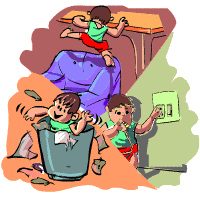
Your Exploring Toddler [Illustration by Shiju George]
He plays with water – in the sink and in puddles
She opens cabinets and pulls everything out
He messes up purses and make-up cases
She touches everything on shop shelves
He approaches dogs, cats and any animal without a care
This little ditty could well be an anthem of parents with toddlers! Some sing it with a sense of fun, others sing it somewhat as a lament.
A toddler’s inexhaustible activity born out of curiosity, may get tiring at times. But it’s the most important way in which your child learns – by exploring her environment.
As she stumbles upon something new, it stands to reason that she must know everything about it. This is how she gets acquainted with the world.
How things work, what they look like from the inside (that can be learnt only by taking them apart) and how they are made, are the urges that drive her.
After all, these activities help build skills like pulling up, standing, crawling, walking, climbing and running all of which comprise aids for children to test out their environment. The parents’ role is to take care that the child’s exploration should happen in safe places.
A child between one and three years of age wants to be part of whatever adults do. She will try to imitate you. She will also insist on trying to do many things by herself. And sometimes she will strongly resist your help.
It is one of the most rewarding experiences to see parents with a crease or two on the brow and a stiff bone, follow the child’s trail gamely – at a friendly pace.
They realise that they are witness to one of the most fascinating mysteries of life when they see the ceaseless efforts of the child to gain control over its body and mind faculties – the gradual comprehension of taste, touch, sight and smell and development of eye-hand coordination
By tapping her sipping cup on the table, the child learns about the sound it makes. By shaking it, she learns how to tell whether it is empty. And by turning it upside down, she discovers she can make a mess!
And when the toddler knows that she can explore her environment and yet return to a parent when she needs help, she becomes secure and confident.
Just watching the little tornado can be exhausting for the parent and that’s one reason why they need to be aware of what their child is doing. It is surprising how many dangerous places and objects toddlers can discover.
You won’t have to be on guard with your toddler so often if you make your house friendly and safe for her, for she does not have much thought for safety when all she wants is to put a finger into an electrical socket. There are a few points you can keep in mind though:
- Put away the cut glass and ornamental objects till the toddler grows up and do not clutter the house with excessive furniture.
- Use safety gates on stairways and porches.
- See that the windows have grills.
- Cover electrical sockets and see that they are removed from floor level to an unreachable height.
- Do not keep medicines lying around at places where the toddler can reach.
Play and Learn
- Your toddler is very active between the ages one and three. Between one and three years of age the child will use her brand new physical and verbal skills to explore and then to play.As she grows, your toddler will spend less time exploring and more time playing. And play is your child’s “work” as she practices and masters new mental, physical and social skills. To help your child with her development, plan ways for her to do new and interesting activities at home and in your neighborhood:
- Think about new play ideas involving shapes, colours, textures and sizes.
- Introduce her to new places like parks, zoos, even stores. Talk about what you find there.
- Provide safe places for her to crawl into, hide in, climb and explore. For example, you could drape a bed sheet over a table to make a pretend cave.
- Talk about what you see and hear while walking, riding the bus or driving in the car.
Explore with questions
- At this stage she is getting better and better at talking and listening – and at watching other people around her. Every utterance begins with a why.Children ask questions in bits and pieces because they need time to assimilate the response. Explaining to a two-and-a-half year old in a manner that is appropriate for her developmental stage is an art that comes better with more and more practice!
The next time you meet an adult who throws in two whys in every three sentences find out if she has a toddler at home!










